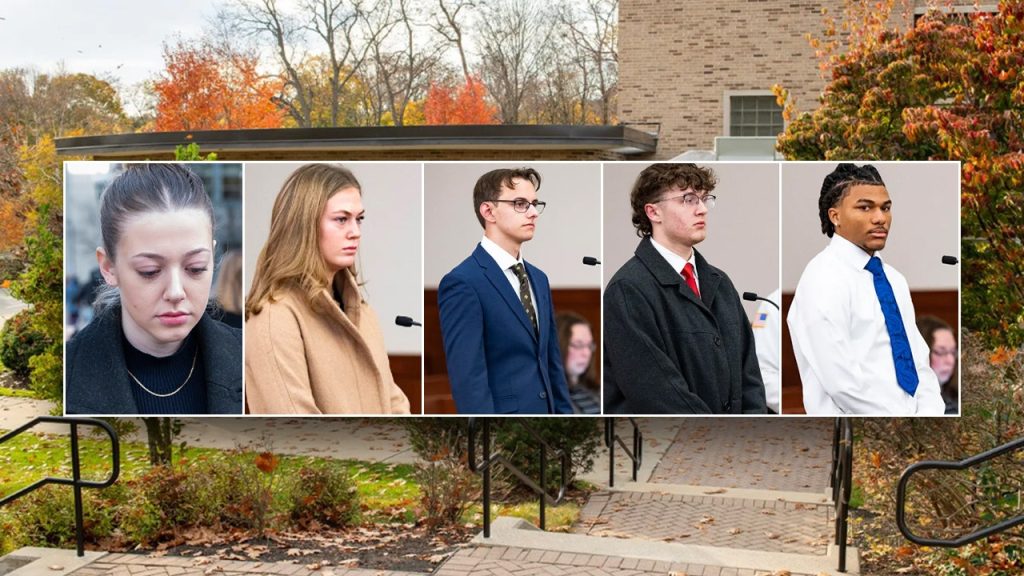This incident revolves around a “To Catch a Predator”-inspired prank gone wrong at Assumption University in Massachusetts. Six students, five identified as Easton Randall, Kevin Carroll, Isabella Trudeau, Joaquin Smith, and Kelsy Brainard, with the sixth being a minor, allegedly conspired to lure a 22-year-old Army soldier to campus using the dating app Tinder and then physically assault him. The soldier, who had just attended his grandmother’s funeral, was in Worcester and looking for companionship when he matched with Brainard. He maintained that he was using the app for its intended purpose – to connect with someone – and police found no evidence suggesting he was seeking minors.
The plan orchestrated by the students involved Brainard initiating contact with the soldier through Tinder. While her profile indicated she was 18, the students’ intent was to portray her as younger to create a scenario where they could accuse the soldier of predatory behavior. Upon the soldier’s arrival on campus, he and Brainard sat together in a student lounge, seemingly without any inappropriate interaction. Security footage corroborated this, showing them maintaining personal space and Brainard appearing relaxed and engaged.
However, the situation rapidly escalated when a group of 25-30 students, alerted by the accused, ambushed the soldier, accusing him of being a pedophile. They surrounded him, preventing his escape, and pursued him as he broke free, using their phones to record the chase. During this pursuit, the soldier was physically assaulted – punched in the head by the juvenile student and his head slammed into his car door by Carroll. As the soldier fled in his vehicle, students continued their aggression, kicking his car.
Following the assault, the group of students returned to the building, displaying celebratory behavior, including high-fives and laughter, as captured by surveillance cameras. Brainard then contacted campus police, falsely reporting a “creepy guy” seeking an underage girl and claiming the soldier arrived uninvited. This narrative, however, unraveled as campus police investigated, reviewed security footage, and compared their findings with a report filed by the soldier with Worcester police, detailing the assault.
The investigation uncovered the pre-planned nature of the incident, revealing text messages and group chats among the accused students discussing their intent to “catch a predator.” The students admitted to being inspired by the “To Catch a Predator” trend on TikTok, where individuals pose as minors online to lure and expose suspected predators. Randall, one of the accused, admitted to police that the situation spiraled out of control.
While Brainard attempted to downplay her role, claiming ignorance of the planned assault, surveillance footage contradicted her statement, showing her laughing and smiling during the attack. The soldier, deeply affected by the incident, deployed to the Middle East shortly after. The five named students have been arraigned on conspiracy and kidnapping charges, with Carroll facing an additional charge of assault and battery with a dangerous weapon. All have pleaded not guilty and are awaiting their next court appearance. The sixth student, a juvenile, has also been charged. Attorneys for the accused students have not commented on the case. This incident highlights the dangers of misguided vigilante justice and the potential for social media trends to incite harmful real-world actions.
The incident raises several important points for discussion. Firstly, the misuse of social media trends can have severe consequences. While the “To Catch a Predator” concept may have started with good intentions, its adaptation by these students demonstrates a dangerous misinterpretation. Their actions were not only unlawful but also caused significant harm to the victim, both physically and emotionally. The incident underscores the need for responsible social media consumption and a critical evaluation of online trends.
Secondly, the case highlights the importance of due process. While the students may have believed they were enacting justice, their actions bypassed established legal procedures for handling such situations. Their vigilante approach undermined the role of law enforcement and the judicial system, leading to a violent and unjust outcome. The incident serves as a reminder that individuals should not take the law into their own hands, regardless of their perceived moral justification.
Thirdly, the case raises questions about the influence of group dynamics. The large number of students involved suggests a herd mentality, where individuals may feel emboldened to participate in actions they would not undertake alone. The celebratory behavior exhibited by the group after the assault further reinforces this notion. The incident underscores the potential for peer pressure to lead to harmful behavior and the importance of individual responsibility within a group setting.
Furthermore, the incident reveals the potential for miscommunication and misinterpretation in online interactions. While the soldier maintained he was using Tinder for its intended purpose, the students interpreted his actions differently, leading to their misguided intervention. This highlights the challenges of accurately assessing intent and motivation in online communication and the need for caution when interpreting online interactions.
Finally, the incident raises concerns about the impact of such events on the victim. The soldier, already dealing with the grief of losing his grandmother, was subjected to a traumatic experience that undoubtedly caused significant emotional distress. His subsequent deployment to the Middle East suggests the incident may have further exacerbated his emotional state. The case emphasizes the importance of considering the long-term consequences of such actions on the victims and the need for support and resources for those affected by vigilante justice.
In conclusion, the incident at Assumption University serves as a cautionary tale about the dangers of misusing social media trends, the importance of due process, the influence of group dynamics, the challenges of online communication, and the impact on victims. The case underscores the need for responsible social media use, critical thinking, and a commitment to upholding the principles of justice and fairness in both online and offline interactions.

